Polish Vikkers: Light tank 7TP
It is worth noting that in the interwar period, few of the European army had doubts that tanks would play a decisive role on the battlefield. This was well understood in Poland, for this reason the Polish military leadership made the main emphasis on the development of its own tank building in the country. However, this development needed at least some kind of base. Therefore, like most of the states that gained independence following the results of the First World War, Warsaw acquired foreign armored vehicles for quite a long time.
The first tanks of Poland in 1919 were the light tanks Renault FT-17 received from France, which proved themselves quite successfully during the First World War, acting on the Western Front. It was Renault FT-17 tanks before 1931 that formed the basis of Polish tank forces, until there was an urgent need to replace this outdated fighting vehicle with something. To replace the Polish military considered several options, among which the American tank M1930 designed by Christie and the British Vickers Mk.E (better known in Russia as “Vikkers 6-ton”) stood out for the better. However, it was not possible to reach an agreement with the Americans, so the Poles turned to Vickers, whose tank had already attracted the delegation of the USSR, and later served as a prototype for the Soviet T-26 tank.
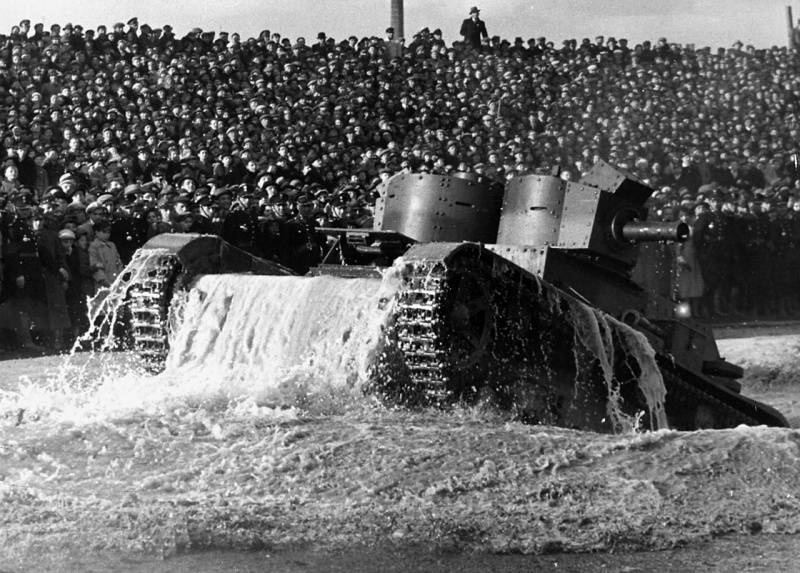
In 1930, the Polish military delegation signed a contract for the supply to the country of 50 Vickers Mk.E tanks, of which the Poles had to assemble 12 combat vehicles on site with their own hands. The tank made a very favorable impression on the military, but there were also a number of shortcomings - insufficient booking, weak armament (of the 2 machine gun in total), unreliable powerplant. In addition, the cost of one Vickers reached 180 thousand zlotys, a considerable amount for those times. In this regard, already in 1931, the Polish government decides to create its own light tank on the basis of the English tank. Work on the modernization of the combat vehicle was deployed at the end of 1932 year. Poles placed considerable hopes on the new tank - suffice it to say that the contract for the supply of the army of the first batch of new tanks was signed on 19 in January of 1933, and the design work was completed only on 24 in June of that year.
The chassis of the tank has not changed, completely moving from the "Vickers". The suspension consisted of 4-s two-wheeled carts, which were interlocked in pairs with suspension on leaf springs, 4-x supporting rollers, as well as front drive and rear guide wheels (on each side). The track chain was fine-grained, it consisted of 109 steel tracks 267 mm wide. The length of the bearing surface of the tank tracks was 2900 mm. Unlike the undercarriage, the body of the Polish tank was modified by mounting an armored casing located above the engine compartment. At the same time, the tank reservation was also increased: the thickness of the front hull sheets was made by the Poles to 17 mm, onboard - to 13 mm.
They decided to leave the tank’s armament fully machine-gunned, it consisted of two 7,92-mm machine guns wz.30 installed in two cylindrical towers, which were similar in design to the English ones. For its time, the Browning wz.30 machine gun of the 7,92-mm caliber had good characteristics. Its maximum rate of fire was 450 shots / min, the initial speed of the bullet 735 m / s, the maximum firing range - up to 4500 meters. At a distance of 200 meters, this machine gun punched 8-mm armor, so it could be effectively used to combat lightly armored targets. The ammunition of two tank machine guns consisted of 6 thousands of cartridges. Polish designers used cylindrical housings to protect the barrel with a liquid cooling system. Each tank turret could rotate 280 °, and the vertical guidance angles of machine guns ranged from -10 ° to + 20 °. In this case, the Poles executed the design of the machine-gun installation so that instead of "Browning" you could always install machine guns Maxim wz.08. or Hotchkiss wz.Xnumx.
Replaced and subjected to the British engine, which was considered unreliable and flammable. It was replaced by the Saurer 6-cylinder diesel engine, which developed the power of the HP 110. at 1800 rpm The engine cooling system was fluid. Inside the crew compartment and engine compartment, air circulation was provided by two fans. The fuel tanks were in the front of the tank. The main tank with a capacity of 110 liters was located next to the driver's seat, and the spare capacity of 20 liters was next to the gearbox. When driving on a highway, a tank could spend up to 80 liters per 100 kilometers, and when traveling over rough terrain, consumption increased to 100 liters.
Transmission combat vehicle was in front of the hull. It included the drive shaft, main and side clutches, control drives, final drives and a gearbox. The maximum speed on the highway was 37 km / h. The speed of 1 km / h on 7 gear, 2 km / h on 13, 3 km / h on 22 and 4 km / h on 37.
The crew of the light tank included 3-man. In front of the hull on the right was the place of the driver, the commander of the combat vehicle occupied the right tower, the second shooter left tower. Observation devices installed on the tank, were simple and few. Each side of the turret had two slits, which were covered with bulletproof glass, and telescopic sights were installed next to the machine guns. For the driver, only a front double-leaf hatch was provided, in which an additional viewing slot was cut out. Periscopic observation devices were not installed on twin-wheeled light tanks 7TP. At the same time, a version of a single-turret tank armed with an 37-mm Bofors tank gun and an 7,92-mm machine gun wz.30 paired with it was in development.
The first prototype of a light tank 7TP entered testing in August 1934. Although there was enough time to create a full-fledged prototype, it was partially made of non-iron steel. Sea trials were conducted from August 16 to September 1 1934, for this time period the tank passed 1100 km. The second prototype of the tank in the gland was delivered for testing ground tests 13 August 1935 year.
A comparison of the new lightweight Polish tank with the British Mk.E does not make it possible to doubt that the Polish engineers were able to optimize the design of the combat vehicle, making the tank more reliable. But the most significant changes were related to improving engine cooling, replacing weapons and strengthening the suspension. After the production of prototypes and their inspection by the military, the army issued an order for the construction of light tanks 7ТР (7-Tonowy Polsky).
At the same time, already in 1935, it was quite obvious that the two-turreted version of the 7TR light tank does not have any reserves for further modernization. For this reason, the main emphasis was placed on a single-mounted version of a tank with cannon armament. However, for a long time the Poles could not decide which gun to put on the tank. From 1934 to 1936 for years, they managed to look at 6 of different versions of guns with a caliber from 37-mm to 55-mm. In this case, the requirements for a tank gun, were quite a standard. The gun should have a high rate of fire, compact size, the ability to deal with enemy armored vehicles, as well as have good performance. After going through all the possible options, the Polish military chose the 37-mm cannon of the Swedish company Bofors. Having learned about the Polish side's desire to place the Bofors gun together with the Polish machine gun, the company representatives offered Poland free assistance in creating the twin construction of the tower armament of the 7Т light tank. In addition, the Swedes equipped the Polish tank with the Zeiss company sights. As a result, the Swedish side manufactured the tower according to the drawings provided from Poland. In many ways, it looked like a Vickers turret.
Work on the tower was carried out in Sweden from December 1935 to November 1936, when Bofors presented the Poles with a finished tower, with an 37-mm cannon installed in it. At the same time, the Polish side refused to continue the supply of towers from Sweden. Instead, with the help of engineer Fabrikovsky, a new “adapted” design was designed, which was designed to be installed on the first prototype of the 7TR tank. The changes affected only the podbashnoy box and the placement of batteries, which are moved from the crew compartment to the transmission one. The turret was made in the shape of a truncated cone and had a differentiated reservation. The frontal part, the sides, the stern and the mask of the gun were made of identical armor plates with a thickness of 15 mm, the roof of the tower was of a thickness of 8-10 mm. Due to the layout of the tank hull, the turret had to be placed on the combat vehicle with a shift to the left side.
In the period from 3 to 7 February 1937, tests were carried out that showed the suitability of the towers for installation on 7ТР light tanks. Serial products differed hatch on the roof of the tower, and not in the stern broneliste, as well as the presence of a feed niche. The niche was at the same time a counterweight for the tank guns and a place to install the N2C or RKBc radio stations, which began to install 1938 on the Polish tanks in the fall. In total, before the start of the Second World War, only 38 radio stations were collected. As a result, they appeared on the tanks of platoon commanders, companies and battalions.
It is worth noting the fact that at that period of time the 37-mm Bofors cannon was enough. The gun had excellent characteristics and fighting qualities, it was enough to destroy all the tanks that were available at that time. At a distance of up to 300 meters, a projectile fired from such a gun pierced armor up to 60 mm thick, from a distance of up to 500 meters - 48 mm, to 1000 meters - 30 mm, to 2000 meters - 20 mm. The gun’s rate of fire was 10 rds / min. The ammunition of the gun consisted of 80 shells and was located inside the tank as follows: 76 shots were stored in the lower part of the fighting compartment, and 4 in the tank turret. Ammunition paired with a gun 7,92-mm machine gun wz.30 was 3960 ammunition.
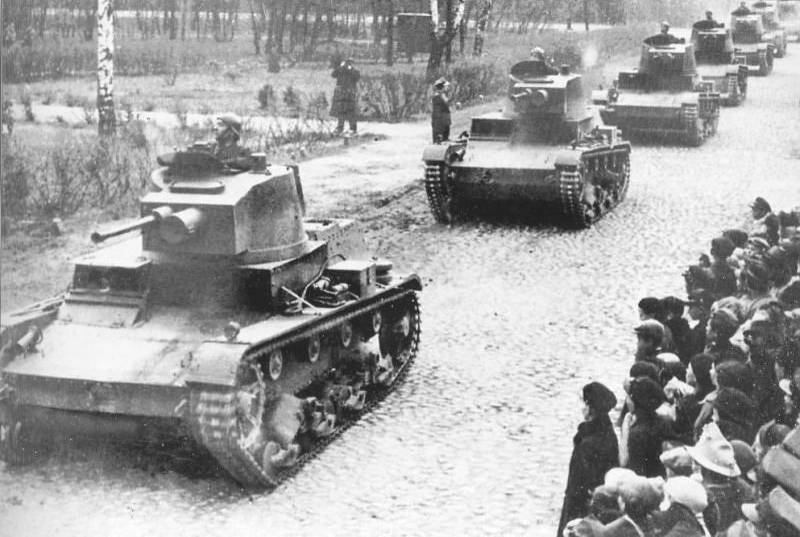
The first combat firing of the new tank took place in 1937, at the bases of the Ballistic Research Center, located in Zelenka, not far from the Polish capital. At the same time, the price of one tank with artillery armament has grown to 231 thousands of zlotys. The main production site for light tanks 7TR from 1935 to 1939 was a factory located in Czechowice. In total, 139 produced such tanks, of which 24 were double-turreted and were armed only with machine guns. However, later all double-tower tanks were upgraded, they had one gun turret installed.
Before the beginning of World War II, 7Т and 1 battalions of light tanks of the Polish army were armed with 2Т tanks (49 combat vehicles in each). Shortly after the start of the war, already on September 4, the 1939 of the Year in the Training Center of the Tank Forces, located in Modlin, the formation of the 1 Tank Company of the Warsaw Defense Command ended. The company consisted of 11 tanks 7ТР. Another 11 of this type of tanks was in the 2 of the company of light tanks of the Warsaw Defense Command, which was formed slightly later.
It is worth noting that the Polish 7TR light tanks possessed better armament than the numerous German light tanks Pz.I and Pz.II and the best maneuverability, not yielding to German tanks in armor. As a result, the 7ТР tanks managed to take part in the hostilities, destroying and damaging approximately 200 German tanks during the entire fighting. In particular, these Polish tanks took part in the Polish army’s counter-strike under Piotrkow Trybunalski, where on September 5 1939 one tank 7ТR from the 2 battalion of light tanks hit 5 of German light tanks Рz.I. The longest with the German troops fought tanks from the 2-th tank company, which defended Warsaw, they took part in street battles in the city until September 26 1939.
Most of these combat vehicles were lost in the battles, some undermined by their crews, or even sunk in the Vistula. But a number of tanks (before 20) were captured by the Nazis, who then used them during World War II. At least another 4 of a wounded 7TR tank and one tractor at its base were captured by the Red Army in the process of annexing Western Belarus and Western Ukraine to the USSR in September of 1939. Soviet engineers paid close attention to these Polish tanks. All tanks captured by Soviet units were damaged, so they were first repaired at Repair Base No. XXUMX, located in the capital of Ukraine, as well as at the Kubinka Armored Test Site.
After that, the tanks passed a series of tests in the Soviet Union. According to the results of the tests, the designers noted that the following elements of the Polish Vickers were of interest to the USSR tank industry: armor protection for a mask of a machine-gun installation in the tank turret, a diesel engine manufactured by Zaurer, and viewing instruments. In the latter case, the discussion was about a circular view survey device of the 1934 model of the year, which was created by the engineer Rudolf Gundlah. Starting from the 1936 year, similar devices were produced in Lviv, the Poles put them on TKS tankettes and 7TR light tanks. A patent for the production of this tank periscope was later sold to the British company Vikkers Armstrong. During the Second World War, all British tanks were equipped with similar surveillance devices. Soviet engineers also copied the Polish periscope, then using it in their combat vehicles.
Tactical and technical characteristics of the tank 7TP:
Overall dimensions: length - 4,56 m, width - 2,43 m, height - 2,3 m.
Combat weight - 9900 kg.
Reservations: hull forehead - 17 mm, hull sides - 13 mm, turret - 15 mm, hull roof and bottom - 5 mm.
Armament - 37-mm cannon Bofors (80 shells) and 7,92-mm machine gun WZ. 30 (3960 ammo).
The power plant - 6-cylinder diesel engine Saurer CT1D with power 110 hp
Maximum speed - 37 km / h (on the highway).
Power reserve - 160 km (on the highway), 130 km (over rough terrain)
Fuel supply - 130 l.
Crew - 3 man (driver, commander-loader, gunner).
Information sources:
http://www.aviarmor.net/tww2/tanks/poland/7tp.htm
http://www.istpravda.ru/research/5110
http://szhaman.com/polskie-tanki-7tr
http://www.opoccuu.com/7tp.htm
Open source materials
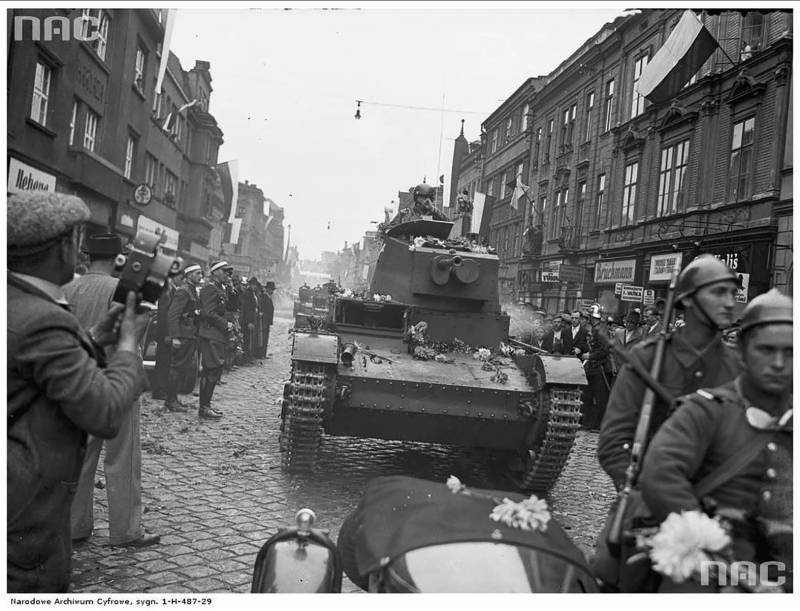
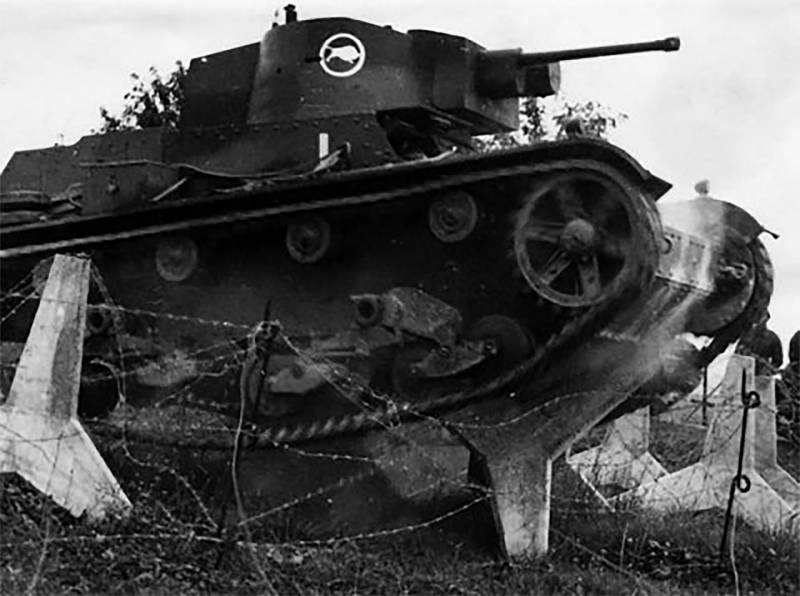
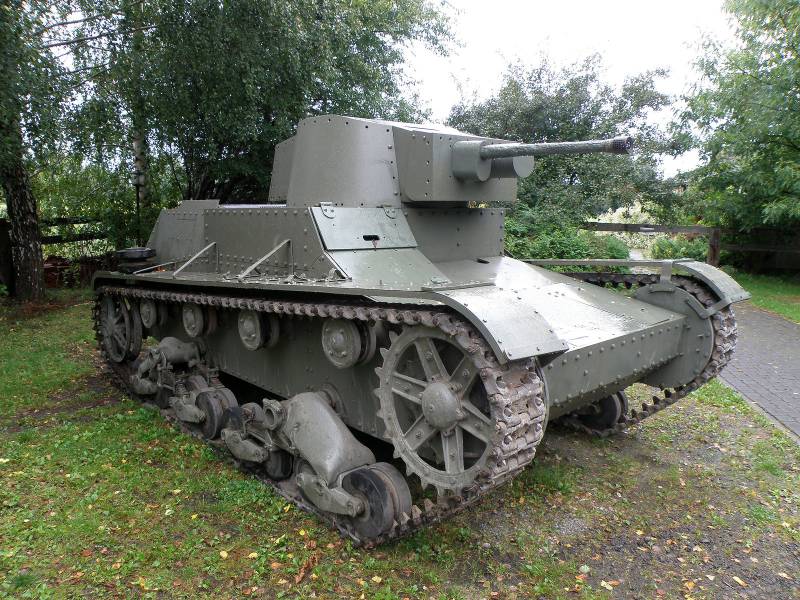
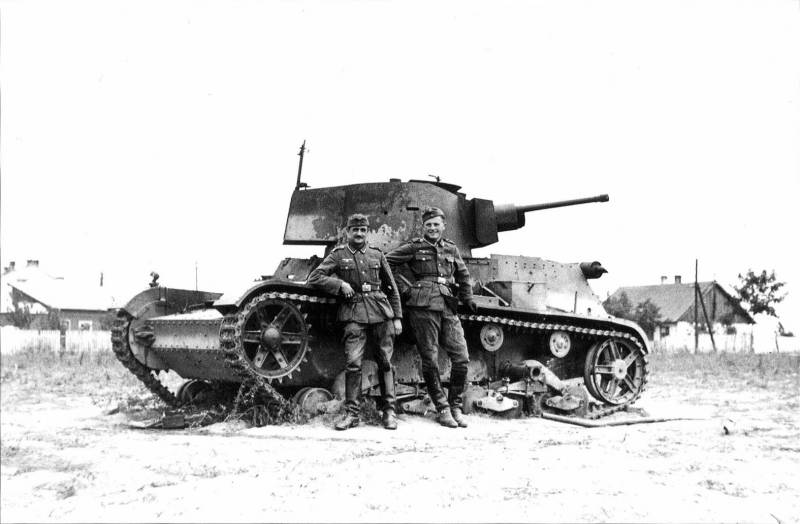
Information